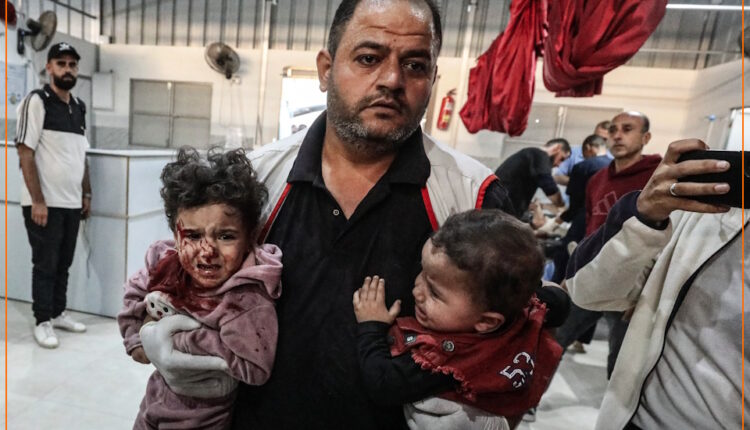Shattered Truce: Israel Accused of Nearly 500 Ceasefire Violations in 44 Days, Undermining Gaza Peace Efforts
A U.S.-brokered ceasefire, designed to halt a devastating conflict and facilitate humanitarian aid, is facing collapse as Palestinian authorities report systematic and lethal violations by Israel, resulting in hundreds of casualties and a deepening crisis in the Gaza Strip.
Systematic Violations and Mounting Casualties
According to the Gaza Government Media Office, Israel has violated the terms of the ceasefire agreement at least 497 times in the 44 days since it came into effect on October 10. These breaches have had a devastating human cost, with Palestinian sources stating that hundreds have been killed, including at least 342 civilians, the majority of whom were children, women, and the elderly.
In a strongly worded statement, the Media Office condemned what it called “the continued serious and systematic violations of the ceasefire agreement by the Israeli occupation authorities.” It asserted that “these violations constitute a flagrant breach of international humanitarian law and the humanitarian protocol attached to the agreement.”
The most recent wave of attacks occurred this past Saturday, with 27 reported violations resulting in 24 fatalities and 87 wounded. The office holds Israel “fully responsible for the humanitarian and security repercussions” stemming from its actions.
A “Ceasefire in Name Only”
On the ground, the reality for Palestinians stands in stark contrast to the promised peace. Al Jazeera’s correspondent in Gaza City, Tareq Abu Azzoum, described the situation as a “ceasefire in name.” He reported that “in reality, despite the announced pause, the Israeli forces carried out a series of air strikes across Gaza,” leaving residents with a “shattered sense of safety.”
“This reinforces the belief,” Abu Azzoum added, “that the Gaza deal has been treated as a tactical withdrawal rather than a genuine binding commitment.”
Contested Narratives and the “Yellow Line”
The ceasefire, mediated by the United States, included a key provision known as the “yellow line“—an unmarked boundary within Gaza where Israeli forces were to reposition, theoretically ceding control of more than half of the coastal territory to Palestinian authorities. However, the agreement has been marred by conflicting accusations.
-
The Israeli Position: The Israeli government, represented by Prime Minister Benjamin Netanyahu’s office, justifies its military actions as necessary responses to aggression. Following a recent air assault, it stated the attacks were “in response” to a Hamas fighter targeting Israeli soldiers near the yellow line, claiming to have “eliminated five senior Hamas [fighters].” Israel also continues to heavily restrict the flow of humanitarian aid and medical supplies into Gaza, a critical component of the truce, exacerbating the dire conditions in the devastated enclave.
-
The Hamas Rebuttal: Hamas officials have vehemently denied providing pretexts for Israeli attacks. Izzat al-Risheq, a senior member of Hamas’s political bureau, called Israel’s claims “fabricated pretexts to evade the agreement and return to a war of extermination.” He stated, “It is Israel that violates the agreement daily and systematically,” and called on U.S. and international mediators to pressure Israel to provide evidence for its allegations and adhere to the agreement’s terms. Hamas also alleges that Israeli forces have pushed westwards beyond the agreed-upon yellow line, effectively altering the terms of the deal on the ground.
Deepening Humanitarian and Forensic Crisis
The fragility of the truce is further highlighted by several critical issues:
-
Humanitarian Strangulation: Despite ceasefire mandates, Israel’s near-total siege on Gaza continues, severely limiting the entry of food, fuel, water, and medical supplies. This has prevented any meaningful recovery for a population facing widespread displacement, disease, and starvation.
-
Families Under Siege: Local authorities report that dozens of Palestinian families remain besieged in northern Gaza as the Israeli military has repositioned its forces deeper into the territory, violating the withdrawal terms of the agreement.
-
A Crisis of the Dead: In a grim postscript to the conflict, a spokesperson for Gaza’s Forensic Evidence Department revealed a new dimension to the crisis. The department lacks the laboratories and equipment necessary to identify the 330 bodies returned by Israel as part of a prisoner-exchange arrangement under the truce. Many of the bodies show signs of “torture, mutilation, and execution.” To date, only 90 have been identified. “We rely on forensic photography and the observations of the families and face difficulties,” the spokesperson said, issuing a desperate plea for international assistance to provide the equipment needed for proper identification and to uphold the dignity of the deceased.
As violations mount and accusations fly, the internationally-backed ceasefire appears increasingly tenuous, leaving the people of Gaza trapped in a cycle of violence and a deepening humanitarian catastrophe with no end in sight.
Support Dawat Media Center
If there were ever a time to join us, it is now. Every contribution, however big or small, powers our journalism and sustains our future. Support the Dawat Media Center from as little as $/€10 – it only takes a minute. If you can, please consider supporting us with a regular amount each month. Thank you
DNB Bank AC # 0530 2294668
Account for international payments: NO15 0530 2294 668
Vipps: #557320



Comments are closed.